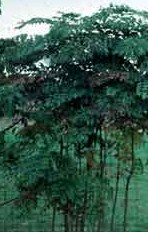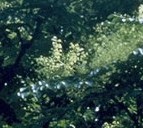 With common names like Devil’s walking stick, and Hercules’ club this plant is bound to attract attention. It is a deciduous small tree or shrub with spines on its trunks, stems, petioles, and leaflets. Growing in open woods, edges of meadows, and along roadsides it is a native of eastern United States from New York to Florida and west to Illinois and Texas but has naturalized elsewhere. Since it suckers freely, it tends to form thickets and can be a formidable barrier. The 3-5’ long leaves and are bi or tri-pinnately compound and are borne in clusters at the end of branches giving a palm tree look to the plant. The leaves are green on top, whitish on the bottom and turn a yellow to bronze-burgundy in fall. Showy masses of white flowers are produced in mid to late summer and in the fall have bunches of blue-black fruits that are attractive to birds. Devil’s walking stick is an adaptable plant and tolerates urban conditions. It thrives in sunny well-drained, moist soils but tolerates rocky, dry or clay soils and partial shade. It is best used in a naturalistic setting and is usually not used in a small garden. In winter the leafless stems covered with spines can be intimidating.
With common names like Devil’s walking stick, and Hercules’ club this plant is bound to attract attention. It is a deciduous small tree or shrub with spines on its trunks, stems, petioles, and leaflets. Growing in open woods, edges of meadows, and along roadsides it is a native of eastern United States from New York to Florida and west to Illinois and Texas but has naturalized elsewhere. Since it suckers freely, it tends to form thickets and can be a formidable barrier. The 3-5’ long leaves and are bi or tri-pinnately compound and are borne in clusters at the end of branches giving a palm tree look to the plant. The leaves are green on top, whitish on the bottom and turn a yellow to bronze-burgundy in fall. Showy masses of white flowers are produced in mid to late summer and in the fall have bunches of blue-black fruits that are attractive to birds. Devil’s walking stick is an adaptable plant and tolerates urban conditions. It thrives in sunny well-drained, moist soils but tolerates rocky, dry or clay soils and partial shade. It is best used in a naturalistic setting and is usually not used in a small garden. In winter the leafless stems covered with spines can be intimidating.
Type: Large shrub or small multi-stemmed tree
Outstanding Feature: Tropical growth habit
Form: Multi-stemmed, irregular crown
Growth Rate: Slow
 Bloom: Large clusters of small white flowers are borne in mid to late summer.
Bloom: Large clusters of small white flowers are borne in mid to late summer.
Foliage: Three to five foot long leaves are bi or tri-pinnately compound and borne in clusters at the ends of the branches.
Size: 10-25’ H x 10-25’ W
Light: Sun to partial shade
Soil: Lean to average, humus-rich, moist, well drained, slightly acidic but tolerates a wide range of soil conditions.
Hardiness: Zones 4-9
Care: Remove unwanted suckers to control size
Pests and Diseases: None of importance
Propagation: Seed, division, root cuttings.
